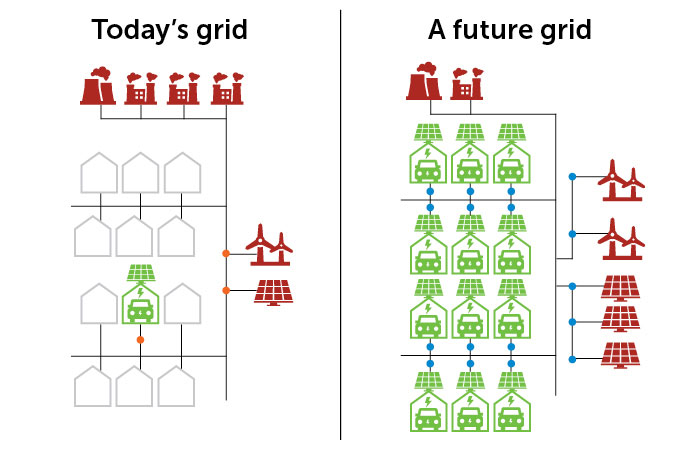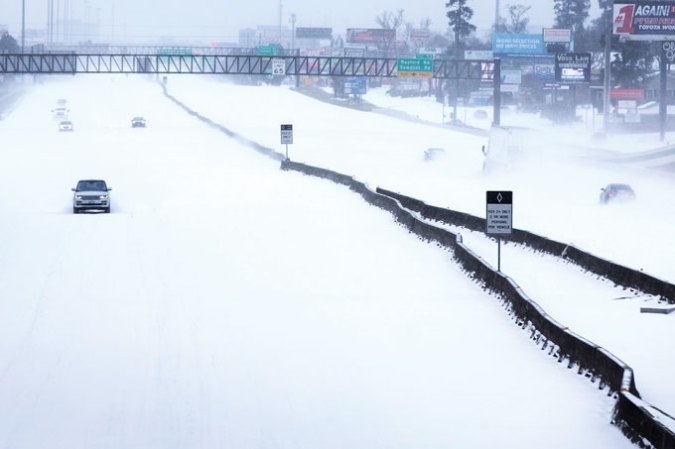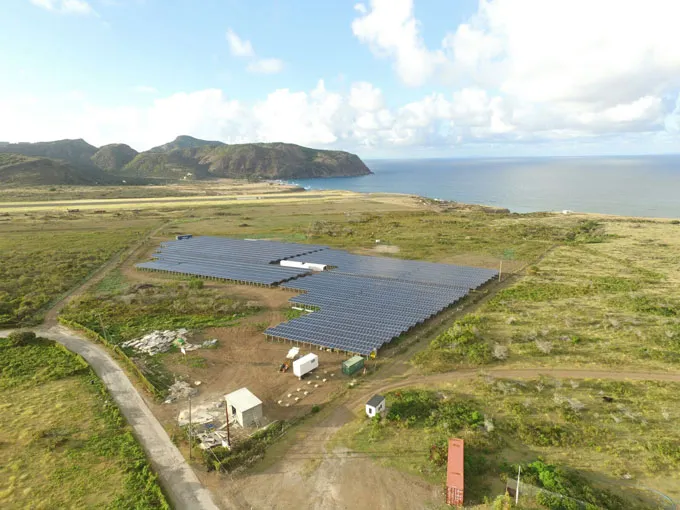How one device could help transform our power grid
Grid-forming inverters may be key to integrating more solar and wind energy

As more renewable energy comes online and fossil fuel plants are retired, electrical grids around the world need updates to keep them operating stably.
JUAN MIGUEL CERVERA MERLO/ALAMY STOCK PHOTO
- More than 2 years ago
From Colorado to Washington, from Ohio to Pennsylvania, coal-fired power plants are shutting down. The United States is on track to retire half of its capacity to generate electricity from coal by 2026. That’s a remarkably fast decline from coal’s peak in 2011 — and a major step in the shift to clean energy and the fight against climate change.
But there’s a surprising downside to retiring big, old power plants. These plants help maintain the power grid’s stability. As more of them go offline, something else must step up to do that job.
An electrical grid is a complex network involving systems that produce power, like a nuclear power plant or a wind turbine, and systems that store and transmit power, like batteries and transmission lines. A grid can stop functioning for any number of reasons, such as a tree falling on a power line or a heat wave overwhelming the system’s capacity. In the United States, electricity pulses through the grid like a heartbeat at a standard frequency of 60 hertz. That frequency can shift if demand increases beyond supply or if something in the system like a large generator goes offline. Even a small interruption in that 60-hertz heartbeat can cause ripple effects that the grid struggles to recover from.
Large power plants are designed to help the grid be resilient to these ripple effects. The inertia of their spinning generators buys time in the event of an unexpected power outage, and they continuously adjust their power output based on the frequency in the grid, keeping everything stable. But a power grid that incorporates large amounts of renewable energy, such as from wind turbines and solar panels, works very differently. It relies on devices known as inverters to convert the direct current, or DC, electricity produced by wind and solar facilities into alternating current, or AC, electricity for the grid. And renewable energy systems involving inverters don’t behave like traditional power plants do. “We’re dealing with a completely different physical system,” says Patricia Hidalgo-Gonzalez, an electrical engineer at the University of California, San Diego.
The rise of renewables
More U.S. electricity is now coming from renewable sources. Grid-forming inverters will likely play a large role in getting the energy safely into the power grid.
So researchers have been looking for ways to keep the grid stable as large power plants are retired and renewable energy makes up a larger percentage of U.S. electricity generation. The answer may lie in a special type of inverter, known as grid-forming inverters. These pieces of electrical equipment, which range in size from smaller than a microwave to as big as a shipping container, are specially programmed to work at the interface between something that produces or stores power — like wind turbines, solar panels and batteries — and the grid. Crucially, they are able to control the flow of renewable energy into the grid quickly and responsively, in ways that mimic the control from large power plants.
By adding some grid-forming inverters into an existing power grid, engineers can help replace the functions that are lost when the big plants retire. Grid-forming inverters also have other advantages, such as automatically restarting a grid that has gone offline. That can make society more resilient to the power outages that come with extreme weather fueled by climate change, such as heat waves and hurricanes (SN: 2/15/20, p. 22).
Solar and wind see a boom
The amount of U.S. electricity generated by solar and wind power has increased dramatically over the last decade.
What is a grid-forming inverter?
Think of a grid-forming inverter as a mother duck with a bunch of baby ducklings trailing after it, says Dominic Gross, an electrical engineer at the University of Wisconsin–Madison. A grid-forming inverter can inject voltage into a grid and then adjust its frequency according to however much power is flowing through the system. Other sources of electricity flowing into the grid, the baby ducklings, can then synchronize with that grid-forming inverter, just as they did with the flow of electricity that pulsed from power stations.
That gives grid-forming inverters a key role in getting more renewable energy into the power grid. Manufacturers including General Electric, Siemens, Tesla and Hitachi already make these devices, and they have been used for decades in isolated power grids, such as on small islands. Today, their use is expanding rapidly around the world as big power companies turn to the devices to handle the boom in renewable energy.
Adding grid-forming capabilities into renewable energy power systems is an easy first step that can make a dramatic difference in building a robust grid for the future, says Julia Matevosyan, chief engineer at the Energy Systems Integration Group in Austin, Texas. “We really have this window of opportunity now,” she says.
The future power grid
Coal-fired and natural gas power plants are the backbone of today’s U.S. electrical grid. Wind and solar farms play a smaller role and use grid-following inverters (orange) to get more intermittent electricity into the system. But grid-forming inverters (blue) could help make way for a future grid that relies primarily on renewable energy. In the grid of the future, every home could have solar panels, and electric vehicles would have bidirectional charging, allowing them to return energy to the grid.

If you have solar panels on your house, you probably have an inverter in your garage. Energy companies use similar inverters at wind and solar power farms to convert large amounts of DC electricity into AC electricity to feed into the grid. But most of those are what’s known as grid-following inverters. They are like the baby ducklings trailing after their mother — they can do a few things on their own but they aren’t capable of running the system like an adult duck can.
A grid-forming inverter, though, can sense the changes in the grid and respond in real time to adjust its frequency, which injects more or less power as needed to stabilize the grid. Florian Dörfler, an electrical engineer at ETH Zurich, compares a group of grid-forming inverters in a power grid to a bunch of spinning bicycle wheels connected by an elastic band. If one of the wheels starts to slow a bit for some reason, the elastic band will transfer momentum from the others and bring it back into synchrony with the group.
Who’s using grid-forming inverters?
Grid-forming inverters aren’t entirely new; they have been used around the world for decades for certain purposes. In the United States, they are mostly in microgrids, small electric power systems supplying isolated areas such as islands or small facilities.
In the 2010s, for instance, a group of researchers and industry professionals built a microgrid that incorporated grid-forming inverters at the Santa Rita Jail in Dublin, Calif. The microgrid used rooftop solar panels, five wind turbines, a fuel cell and battery storage to create a self-contained power system that operated for daily use but could also keep running independently from the main power grid in the event of an outage — crucial to maintaining security. Other microgrids that use grid-forming inverters include a military base on the Hawaiian island of Kauai and the Caribbean island of St. Eustatius.
The challenge now is scaling up from those small, self-sustained systems to larger power grids that incorporate a lot of renewable energy. Several nations have begun this effort, adding grid-forming inverters into their systems.
Australia is perhaps the world leader, with three large renewable energy facilities incorporating grid-forming inverters that recently became operational and three more such facilities in the works, for a total of 480 megawatts of power. A couple of these are in South Australia, where wind power has boomed in recent years. In December, the Australian Renewable Energy Agency announced it was investing 176 million Australian dollars (about $118 million) in eight more projects to produce renewable energy using grid-forming technologies. All together those eight projects are designed to generate 2 gigawatts of power — 10 times the nation’s grid-forming capacity to date and a “groundbreaking” step in the right direction, Matevosyan says.
The United Kingdom is also investing in five new projects, including a 300-megawatt facility in Scotland due to be completed in 2024. In contrast, the United States has done little at the national level to encourage the adoption of grid-forming inverters, even as renewable energy production has roughly doubled in the past decade and now accounts for more than 20 percent of the country’s electricity generation. “The U.S. is probably 10 years behind the curve,” Dörfler says.
That may be changing. The U.S. Department of Energy is funding a $25 million effort to work on how to get more grid-forming inverters into the U.S. power system. The consortium, known as UNIFI, for “universal interoperability for grid-forming inverters,” is in its second of five years of research. It is led by the National Renewable Energy Laboratory in Golden, Colo., along with the University of Texas at Austin and the Electric Power Research Institute in Palo Alto, Calif.
Grids on the edge
Electrical grids are showing their age — and they’re especially vulnerable to the cascading effects that can come with extreme weather. Here’s a look at some recent events that pushed grids to their brink.

February 2021
A deep freeze across much of Texas (shown above) paralyzed electrical equipment and took much of the state’s grid offline, leading to hundreds of deaths.
September 2021
Hurricane Ida knocked out power to more than 1 million people in Louisiana, in part because of transmission lines couldn’t withstand the hurricane’s wind speeds.
May 2022
An intense windstorm across Ontario and Quebec, Canada, toppled power lines and ultimately left nearly a million people without power.
June 2022
A failure at a West Texas power plant triggered more failures across Texas’ grid, including knocking 1.7 gigawatts of solar power generation offline.
January 2023
A surge in voltage shut down Pakistan’s national grid, leaving more than 200 million people without power.
June 2023
A heat dome over northern Mexico and Texas nearly pushed Mexico’s power demand to exceed its supply.
So far, UNIFI has focused on basic issues such as drawing up suggested guidelines for how companies should build grid-forming inverters. Up until now, manufacturers worldwide have been making their own kinds of grid-forming inverters with little to no coordination among them. In December, UNIFI released draft standards meant to serve as a first step toward a national grid code that includes technical specifications for equipment; a second, updated version is expected by the end of the year.
UNIFI recently brought a handful of grid-forming inverters, acquired from different manufacturers, to NREL’s Colorado laboratory. There researchers are testing them in a 1-megawatt power system to see how they fare working in the same grid. A similar UNIFI effort is testing the performance of a larger number of grid-forming inverters made by two different manufacturers in a 20-megawatt system on Kauai.
The goal is to see whether inverters from different manufacturers can be smoothly integrated into a large power grid, and how much programming work it will take to get them to play nicely with one another. “How do you make millions of these things work together, collaboratively, in a large-scale network systems context?” asks Gross, who works with UNIFI. Such tests are just early steps in getting the United States caught up with other countries that already have grid-forming inverters working in their large power grids.
UNIFI hopes to raise the profile of grid-forming inverters and provide guidance to what is currently a Wild West landscape of different companies that manufacture them. But it will have to move fast to make a difference. “We are literally talking about transforming the entire electricity sector in like 15 years,” says Ben Kroposki, director of the power systems engineering center at NREL and the organizational director for UNIFI. “It took 140, 150 years to build what we have today. And so that’s just a monumental shift in the electric power sector.”
Inverters in a typical home solar panel system can cost several thousand dollars, with the cost higher for industrial-scale systems. But grid-forming equipment isn’t necessarily more expensive to produce than grid-following equipment is. Manufacturers charge a bit more to cover their research and development costs, but the difference is minimal for the benefit gained, Matevosyan says. Even as some nations are incentivizing energy companies to put in grid-forming technologies, she says that anyone building grid components today should incorporate them as a matter of course. “It just makes sense to have them grid-forming,” she says. “You can future-proof it.”
What are the open questions?
Even as grid-forming inverters are adopted, there are research questions yet to be answered. One challenge is that it’s not yet clear how many inverters in grids of the future will need to be grid-forming. Theoretical calculations suggest that some grids will operate just fine getting 60 to 70 percent of their power from renewable sources using grid-following inverters. But others might crash at just 20 percent and will need to have more grid-forming inverters in the mix, Gross says.
The number for any grid will depend on factors such as the grid’s age, stability and geometry. A densely interconnected network of power production facilities such as in Europe might need a much smaller percentage of grid-forming inverters than a long, strung-out network such as that along the Australian coast.
The U.S. power grid is actually three separate grids, in the eastern and western parts of the country and in Texas, all with varying inverter needs. And some power operators might choose to disconnect their coal- or gas-fired plants but retain some large nuclear or hydroelectric facilities, which would continue to support the synchrony of the grid and demand fewer grid-forming inverters.

Other research frontiers include figuring out new ways to diagnose and fix problems in the grid. A short circuit in a grid component, for example, can suddenly inject large amounts of current, a surge that traditional power plants can handle automatically by disconnecting the malfunctioning part. Grid-forming inverters cannot tolerate large spikes in current, making it harder to solve these problems in real time. “How to do so efficiently and safely is still a big research question,” says Rodrigo Henriquez-Auba, an electrical engineer in Mountain View, Calif., who works with UNIFI.
Some scientists, including Dörfler, are exploring how a power grid with a lot of grid-forming inverters could provide power in new ways. By taking extra steps to optimize how the inverters work together, researchers can move the system closer to what some describe as a virtual power plant — in which many small-scale renewable energy devices effectively function as a single traditional power plant. That might mean programming inverters to quickly draw power out of a battery and inject it to make the grid more robust to unexpected fluctuations. Machine learning techniques may help, by training inverters on real-world data to fine-tune operations.
Of course, there are many other challenges to building the grid of the future, such as figuring out better ways to store electricity from solar and wind farms, how to build the necessary transmission lines and how to speed up the connection of renewable power facilities to the grid, currently backlogged due to regulatory issues.
Hidalgo-Gonzalez says that the electrical grid of the future needs to be stronger and more resilient for everyone. Today’s U.S. power grid fosters a lot of societal inequities. It tends to be weak and less reliable, for example, in lower-income communities that are more vulnerable to extreme weather than it is in wealthier communities. In 2021, for instance, Hurricane Ida knocked out power to more than 1 million people in Louisiana, with some lower-income communities not getting it back for weeks.
Renewable energy, bolstered by grid-forming inverters, can play a big role in making the grid more resilient and equitable, Hidalgo-Gonzalez says. “We need to go really fast,” she says, “if we want to take climate change seriously.”







